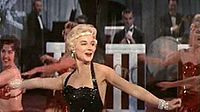Pocketful of Miracles
He then meets Elizabeth "Queenie" Martin, the daughter of a friend and speakeasy owner recently murdered for owing a lot of money to the wrong people.
Dave manages to engineer a lavish reception, with New York's mayor and governor as guests, the night before Louise and her impressed future husband and father-in-law sail back to Europe, none the wiser about her mother's real identity.
Frank Capra had directed Lady for a Day in 1933, and for years, he had wanted to film a remake, but executives at Columbia Pictures, which owned the screen rights, felt the original story was too old-fashioned.
[2] In 1960, Capra bought the screen rights from Columbia for $225,000,[3] and the director made a deal with United Artists, where it was decided to film the story as a period piece set in the 1930s.
[2] Cast as Apple Annie was Bette Davis, who accepted the role after Shirley Booth, Helen Hayes, Katharine Hepburn, and Jean Arthur declined it.
Davis was undergoing financial difficulties, and the need for the $100,000 paycheck overshadowed her concern about making her Hollywood comeback (her last American film had been Storm Center in 1956) in the role of an elderly woman.
[2][4] From the beginning, she clashed with co-star Glenn Ford, who had demanded Hope Lange, his girlfriend at the time, be given the dressing room adjacent to his, which Davis had already been assigned.
[3][4] Because of Ford's involvement with the financing of the film, Capra refused to intervene in any of the disagreements between the two stars, but he suffered blinding and frequently incapacitating headaches as a result of the stress.
[2] Motion Picture Herald covered the preview and gave the film good marks, with the review headline "Pocketful of Dollars" predicting an excellent box office performance.
"[6] The critic for The Hollywood Reporter also looked upon the film favorably, calling it "a Christmas sockful of joy, funny, sentimental, romantic [and] frankly capricious.
In The New York Times, A.H. Weiler noted: "Mr. Capra and his energetic troupe manage to get a fair share of laughs from Mr. Runyon's oddball guys and dolls, but their lampoon is dated and sometimes uneven and listless...Repetition and a world faced by grimmer problems seem to have been excessively tough competition for this plot.
"[2] Variety thought the plot "alternates uneasily between wit and sentiment" and added "The picture seems too long, considering that there's never any doubt as to the outcome, and it's also too lethargic, but there are sporadic compensations of line and situation that reward the patience.
"[8] Least impressed was Elaine Rothschild of Films in Review: "This unbelievable and unfunny comedy proves only that director Frank Capra has learned nothing and forgotten nothing in the 28 years that intervened between the two pictures.
"[2] Filmink argued Ann Margret "is sweet in a small but important part, one of the best things about the movie; she certainly made more of an impact than the bloke who plays her fiancee, another 'discovery' Peter Mann.
